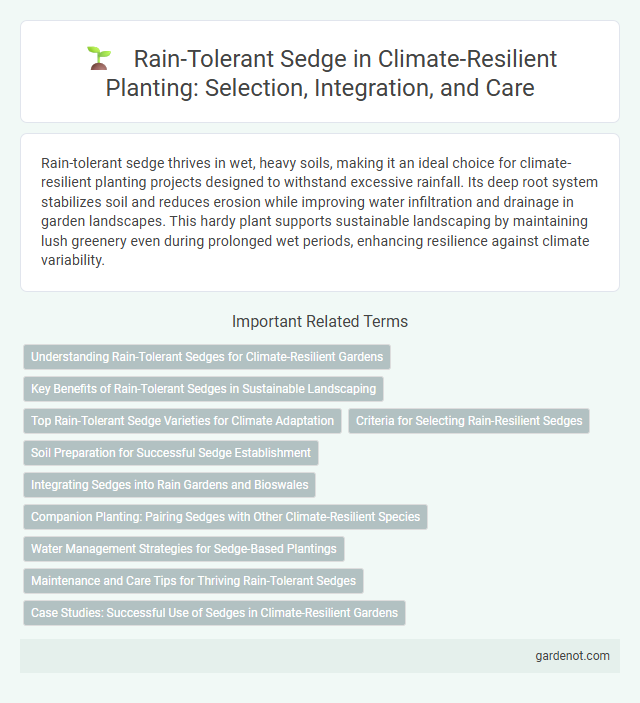Rain-tolerant sedge thrives in wet, heavy soils, making it an ideal choice for climate-resilient planting projects designed to withstand excessive rainfall. Its deep root system stabilizes soil and reduces erosion while improving water infiltration and drainage in garden landscapes. This hardy plant supports sustainable landscaping by maintaining lush greenery even during prolonged wet periods, enhancing resilience against climate variability.
Understanding Rain-Tolerant Sedges for Climate-Resilient Gardens
Rain-tolerant sedges, such as Carex species, thrive in saturated soils and withstand prolonged flooding, making them ideal for climate-resilient gardens facing increased rainfall. These sedges improve soil stability, reduce erosion, and enhance water filtration, contributing to sustainable landscape management. Incorporating rain-tolerant sedges supports biodiversity and helps gardens adapt to extreme weather patterns driven by climate change.
Key Benefits of Rain-Tolerant Sedges in Sustainable Landscaping
Rain-tolerant sedges enhance sustainable landscaping by improving soil erosion control and reducing runoff through their dense root systems. These sedges require minimal irrigation, promoting water conservation in varied rainfall conditions. Their adaptability to wet environments supports biodiversity and resilience against climate-related weather extremes.
Top Rain-Tolerant Sedge Varieties for Climate Adaptation
Top rain-tolerant sedge varieties such as Carex appressa, Carex elata 'Aurea', and Carex acutiformis thrive in saturated soils, making them ideal for climate-resilient planting in flood-prone areas. These sedges not only withstand prolonged waterlogging but also enhance soil stabilization and biodiversity in wetland ecosystems. Selecting these species supports effective adaptation strategies by improving landscape resilience against increasing rainfall variability and extreme weather events.
Criteria for Selecting Rain-Resilient Sedges
Rain-resilient sedges are selected based on their ability to tolerate prolonged waterlogging and periodic flooding, ensuring survival in fluctuating moisture conditions. Key criteria include deep root systems for stability, high water absorption capacity to prevent soil erosion, and adaptability to diverse soil types from sandy to clay-rich substrates. Species like Carex stricta and Carex vulpinoidea demonstrate robust growth in rain-prone environments, making them ideal for climate-resilient planting projects.
Soil Preparation for Successful Sedge Establishment
Optimal soil preparation for rain-tolerant sedge involves thorough site assessment to ensure proper drainage and nutrient balance, enhancing root development. Incorporating organic matter improves soil structure, water retention, and microbial activity, essential for sedge growth in fluctuating moisture conditions. Maintaining neutral to slightly acidic soil pH supports nutrient availability and maximizes sedge establishment in climate-resilient landscapes.
Integrating Sedges into Rain Gardens and Bioswales
Rain-tolerant sedges are essential for enhancing water management in rain gardens and bioswales due to their deep root systems that improve soil infiltration and reduce erosion. Integrating species such as Carex amphibola and Carex vulpinoidea supports stormwater capture and filtration while providing habitat for pollinators. These sedges thrive in saturated soils, increasing climate resilience by withstanding prolonged wet periods and improving urban green infrastructure performance.
Companion Planting: Pairing Sedges with Other Climate-Resilient Species
Rain-tolerant sedge thrives when paired with other climate-resilient species like native grasses and drought-tolerant perennials, enhancing soil stability and water retention. Companion planting with sedges supports a diverse ecosystem by attracting beneficial insects and improving microclimate conditions. This strategic pairing promotes long-term landscape resilience against extreme rainfall and fluctuating moisture levels.
Water Management Strategies for Sedge-Based Plantings
Rain-tolerant sedge excels in water management strategies by efficiently absorbing excess moisture and reducing soil erosion in flood-prone areas. This plant's robust root system enhances soil stabilization while facilitating natural water filtration and retention, crucial for maintaining wetland ecosystems. Implementing sedge-based plantings optimizes stormwater runoff control, promoting sustainable landscape resilience in both urban and natural environments.
Maintenance and Care Tips for Thriving Rain-Tolerant Sedges
Rain-tolerant sedges require minimal maintenance once established, thriving in both wet and poorly drained soils. Regular monitoring for dense growth and occasional trimming helps prevent overcrowding and promotes healthy roots. Applying organic mulch conserves moisture, reduces weeds, and supports soil health, ensuring these sedges remain vigorous during fluctuating rainfall conditions.
Case Studies: Successful Use of Sedges in Climate-Resilient Gardens
Rain-tolerant sedges have proven highly effective in climate-resilient gardens by enhancing soil stability and managing excess water during heavy rainfall events. Case studies from urban parks in Seattle and restoration projects in the Chesapeake Bay watershed demonstrate sedges' ability to reduce erosion and support native biodiversity under fluctuating climate conditions. These examples highlight sedges as crucial components in sustainable landscaping that mitigates flood risks and promotes ecological resilience.
Rain-tolerant sedge Infographic

 gardenot.com
gardenot.com